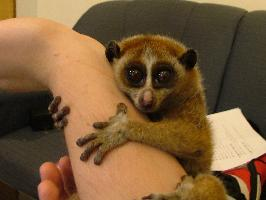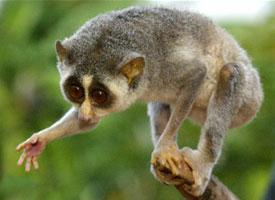
Váhy a míry
| Délka | 30 cm |
|---|---|
| Hmotnost | od 560 do 1200 g |
Biologická data
| Délka života | od 12 do 14 let |
|---|---|
| Délka březosti | od 5,5 do 6 m |
Stav ohrožení
| Ohrožen |
Popis zvířete
The Javan slow loris (Nycticebus javanicus) is a captivating and enigmatic primate that inhabits the dense forests and plantations of Java, Indonesia. This small, nocturnal mammal is part of the lorisidae family, which is known for its unique members, including various species of slow lorises and their close relatives, the slender lorises. The Javan slow loris, with its distinctive round face, large expressive eyes, and a gentle demeanor, has captured the hearts of many animal enthusiasts and researchers worldwide. However, beneath its adorable exterior lies a creature adapted to a life of stealth and survival in the treetops.Physically, the Javan slow loris is a compact animal, typically weighing between 600 to 700 grams, with a body length ranging from 18 to 27 centimeters. Its coat is a dense, woolly fur that varies in color from light brown to deep reddish-brown, providing excellent camouflage among the nocturnal forest canopy. One of its most striking features is the pair of large, forward-facing eyes which grant it excellent night vision, crucial for navigating the dark forest and locating prey. The face of the Javan slow loris is adorned with a distinctive facial mask, with dark patches around the eyes and a white stripe that runs between them, adding to their captivating appearance.
Adaptations of the Javan slow loris are particularly fascinating. Unlike many primates that leap and bound through the trees with speed, the Javan slow loris takes a more deliberate approach. Its movements are slow and meticulous, allowing it to move almost silently through the forest. This stealthy movement helps it avoid predators and sneak up on its prey, which includes insects, small birds, eggs, fruits, and even small mammals. The slow loris has a unique feature among primates: a toxic bite. It has a gland on the inside of its elbow that secretes a toxin, which the loris can combine with its saliva by licking or grooming its fur. This toxic bite is a formidable defense mechanism against predators and is used in disputes with other lorises.
The reproductive habits of the Javan slow loris are marked by their low birth rate, with females typically giving birth to a single offspring after a gestation period of about 192 days. This slow rate of reproduction, combined with habitat loss and the illegal pet trade, has led to a significant decline in their population, making them one of the world's most endangered primates.
The Javan slow loris is a nocturnal creature, spending most of the daylight hours sleeping curled up in the dense foliage or in the hollows of trees. As night falls, it becomes more active, embarking on its solitary foraging expeditions. Despite its slow movements, it is an adept climber, using its strong grip and opposable thumbs and big toes to navigate the complex forest canopy.
Conservation efforts for the Javan slow loris are ongoing but face significant challenges. Habitat destruction due to logging, agriculture, and urban expansion is a major threat, as is the illegal wildlife trade, where they are captured and sold as exotic pets, often subjected to cruel treatment. International and local conservation groups are working to protect the remaining populations through habitat preservation, legal protection, and rehabilitation programs for rescued individuals.
In summary, the Javan slow loris is a remarkable and endearing primate that plays a unique role in the biodiversity of the Indonesian forests. Its survival is crucial, not only for the ecological balance of its habitat but also as a symbol of the global struggle to conserve our planet's incredible and diverse wildlife.
Podobná zvířata
Nové fotografie zvířat
Top 10 zvířat
- Chinese water dragon (Physignathus cocincinus)
- Galápagos tortoise (Geochelone nigra complex)
- Dolphin gull (Leucophaeus scoresbii)
- Japanese macaque (Macaca fuscata)
- Colombian red howler (Alouatta seniculus)
- Sea urchins (Echinoidea)
- Diana monkey (Cercopithecus diana)
- Moustached guenon (Cercopithecus cephus)
- Colossal squid (Mesonychoteuthis hamiltoni)
- Common house mosquito (Culex pipiens)
